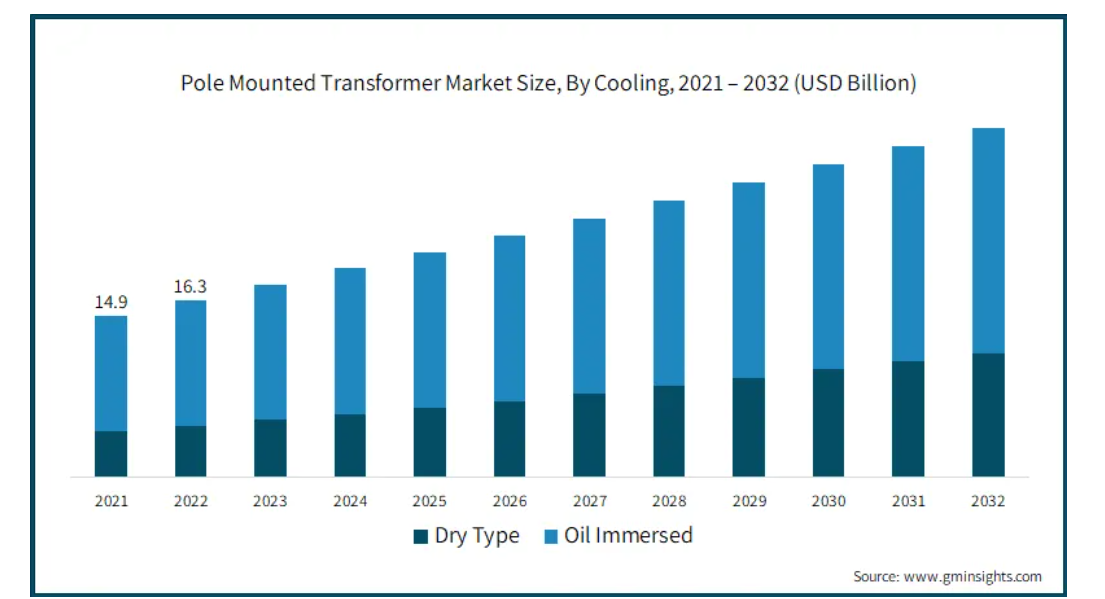As one of the most concerned energy industry topics in recent years, energy storage is not only a concept of sustainable development. It has become a hopeful industry with policies being developed and implemented in numerous countries. However, the rapid development of these industries has also brought forth a surprising issue: transformer shortages. The electrical transformer, which many people may not have noticed in their daily lives, is a type of electrical equipment that uses the principle of electromagnetic induction to alter the levels of AC voltage. It is an indispensable equipment for power transmission and distribution.
 Due to the growth of emerging industries, there is a surge in demand for transformers. According to the forecasts of Spherical Insights, the market size of transformers is growing at a CAGR of 6.14% from 2023 to 2033, the worldwide transformer market size is expected to reach USD 124.16 Billion by 2033. Some reports even suggest that transformer shortages could become a bottleneck limiting the development of the energy storage industry. With the increasing global energy transition and the growth in electricity demand, the transformer industry is now seeking new development opportunities.
Due to the growth of emerging industries, there is a surge in demand for transformers. According to the forecasts of Spherical Insights, the market size of transformers is growing at a CAGR of 6.14% from 2023 to 2033, the worldwide transformer market size is expected to reach USD 124.16 Billion by 2033. Some reports even suggest that transformer shortages could become a bottleneck limiting the development of the energy storage industry. With the increasing global energy transition and the growth in electricity demand, the transformer industry is now seeking new development opportunities.
.png) (Source: Spherical Insights)
(Source: Spherical Insights)
According to the cooling method, transformers can be divided into oil-immersed transformers (using engine oil as a coolant) and dry-type transformers (using fans and natural air cooling). Compared to traditional oil-immersed transformers, dry-type transformers are much safer because they do not contain flammable dielectric fluid, eliminating the risk of oil leakage, fires, and explosions. Additionally, these transformers are more environmentally friendly since they use a natural air-cooling system and do not require frequent maintenance. As a result, dry-type transformers are more efficient and have a longer lifespan.
Dry-type transformers have wide applications. In power generation fields, dry-type transformers are mainly used in thermal power, hydropower, wind power, photovoltaic power, nuclear power, etc. In power transmission and distribution systems, dry-type transformers are mainly used in distribution systems. In addition, this type of transformer finds applications in end-user systems such as railways, industries, infrastructure, and residential buildings. Electric power, industry, and transportation currently dominate the global demand for dry-type transformers. These fields have higher requirements for power system stability and efficient energy utilization, which has further driven the prosperous development of the dry-type transformer market.
In recent years, the continuous development of urbanization and the increasing global population have driven a growing electricity demand. Simultaneously, the expansion of the new energy industry has fueled rapid growth in the transformer market. Moreover, widespread awareness of environmental protection and the implementation of protective policies have significantly contributed to the expansion of the dry-type transformer market. For instance, due to aging power transformers and surging demand, the U.S. Department of Energy finalized new energy efficiency standards for distribution transformers in April 2024. It eases the requirements of the transformer efficiency standard, which will promote the innovation and improvement of transformer technology, particularly as the demand for dry-type transformers continues to rise. According to the research of Markets and Markets, the global dry-type transformer market size is predicted to grow from USD 6.2 billion in 2023 to USD 9.2 billion in 2028. It is anticipated to grow at a CAGR of 6.8% from 2023 to 2028. There is no doubt that the demand for dry-type transformers in North America has increased significantly. GMI Pulse estimated that the dry-type transformer market size in this region will reach USD 6.6 billion in 2032.
.png) (Source: Markets and Markets)
(Source: Markets and Markets)
With the increasing demand for continuous power supply from different countries, in addition to population growth and accelerated urbanization, the Asia-Pacific region is predicted to dominate the dry-type transformer market because of the high electricity demand. China, Southeast Asia, India, South Korea, and Japan are major participants in this region. For example, some countries in Southeast Asia have come up with related policies to support the development of emerging industries and infrastructure construction, so the demand for dry-type transformers will grow. The Vietnamese government released Vietnam’s Eight Power Development Plan (PDP8) from 2021 to 2030 to help boost the Vietnamese power market. The demand for dry-type transformers is growing more with each passing day in Malaysia, and there is a significant decline in demand for oil-immersed transformers, according to the report from 6W Research. The government of India approved Green Energy Corridor (GEC) Phase II in 2022, it is estimated that they will construct 10,750 kilometers of transmission lines and add about 27,500 MVA of new substations in the future. Similar cases have happened in Latin America: according to the survey of Mordor Intelligence, over the past years, the demand for dry-type transformers has been driven by the increasing demand for electricity and the low daily maintenance cost, especially in countries like Brazil, Mexico, Colombia, Ecuador, and Peru. In the Middle East and African countries, they are also expanding and restructuring their distribution power grids.
Driven by emerging technologies, dry-type transformers are also evolving towards intelligence, environmental sustainability, and enhanced efficiency. For instance, in power distribution systems, the two most common types of transformers—pole-mounted and pad-mounted—are poised for rapid growth. One of the most important reasons for the increasing trend is the growing adoption of wind and solar energy. The more solar panels installed on residential rooftops, the more demand for pad-mounted transformers, which are suitable for urban use. Additionally, the growing suburban population contributes to the increasing demand for pole-mounted transformers. Based on the report from ZION Market Research, the global pad-mounted transformer market size is slated to hit USD 11.78 billion by the end of 2032, with a CAGR of nearly 5.56%. In comparison, the pole-mounted market size will reach USD 32.2 billion in 2032, based on research by GMI. These forecasts for pad-mounted and pole-mounted transformers include not only oil-immersed types but also dry types. However, they still demonstrate that dry-type transformers have significant potential for global market expansion.
.jpg)
(Source: ZION Market Research) (Source: Globel Market Insights)
(Source: Globel Market Insights)
CEEG dry-type transformers include various types, such as pad-mounted transformers, pole-mounted transformers, epoxy resin cast dry-type transformers, and mining transformers, etc. It is worth mentioning that we are still trying to find new global markets and development directions. CEEG, guided by "vision, innovation, and responsibility," integrates research, design, manufacturing, and selling all together to provide the highest-quality product, the most excellent service, and the most various solutions!





